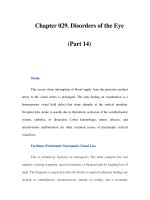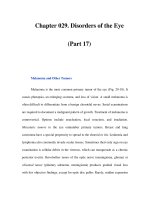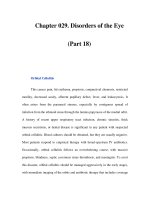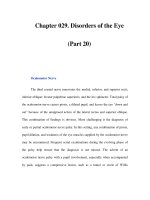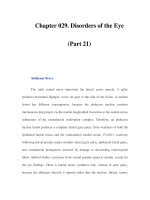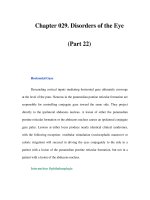Chapter 085. Neoplasms of the Lung (Part 17) docx
Bạn đang xem bản rút gọn của tài liệu. Xem và tải ngay bản đầy đủ của tài liệu tại đây (42.45 KB, 5 trang )
Chapter 085. Neoplasms of the Lung
(Part 17)
Chemotherapy
The chemotherapy combination most widely used for SCLC is etoposide
plus cisplatin or carboplatin, given every 3 weeks on an outpatient basis for four to
six cycles. Increased dose intensity of chemotherapy adds toxicity without clear
survival benefit. Appropriate supportive care (antiemetics, fluid support with
cisplatin, monitoring of blood counts and blood chemistries, monitoring for signs
of bleeding or infection, and, as required, use of hematopoietins) and adjustment
of chemotherapy doses on the basis of nadir granulocyte counts are essential.
The prognosis of patients who relapse is poor. Patients who relapse >3
months since the completion of their initial chemotherapy (so-called
chemosensitive disease) have a median survival of 4–5 months; patients who do
not respond to initial chemotherapy or relapse within 3 months (chemorefractory
disease) have a median survival of only 2–3 months. Patients with chemosensitive
disease may be retreated with their initial regimen. Topotecan has modest activity
as second-line therapy, or patients can be entered onto clinical trials testing new
agents.
Considerations for Therapy of SCLC Limited-Stage Disease
Combined-Modality Chemoradiotherapy
Radiation therapy to the thorax is associated with a small but significant
improvement in long-term survival for patients with limited-stage SCLC (5% at 3
years). Chemotherapy given concurrently with thoracic radiation is more effective
than sequential chemoradiation but is associated with significantly more
esophagitis and hematologic toxicity. In one randomized study, twice-daily
hyperfractionated radiation was compared with a once-daily schedule; both were
administered concurrently with four cycles of cisplatin and etoposide. Survival
was significantly higher with the twice-daily regimen (median survival 23 months
compared with 19 months; 5-year survival 26% compared with 16%), but the
twice-daily regimen gave more grade 3 esophagitis and pulmonary toxicity.
Patients should be carefully selected for concurrent chemoradiation therapy based
on good performance status and pulmonary reserve.
PCI significantly decreases the development of brain metastases (which
occur in about two-thirds of patients who do not receive PCI) and results in a
small survival benefit (~5%) in patients who have obtained a complete response to
induction chemotherapy. Deficits in cognitive ability following PCI are
uncommon and often difficult to sort out from effects of chemotherapy or normal
aging.
Radiation Therapy for Palliation
Palliative radiation therapy is an important component of the management
of SCLC patients. Cranial radiation often decreases the signs and symptoms of
brain metastases. In the case of symptomatic, progressive lesions in the chest or at
other critical sites, if radiotherapy has not yet been given to these areas, it may be
administered in full doses (e.g., 40 Gy to the chest tumor mass).
Surgery
Although surgical resection is not routinely recommended for SCLC,
occasional patients meet the usual requirements for resectability (stage I or II
disease with negative mediastinal nodes). Often this histologic diagnosis is made
in some patients only on review of the resected surgical specimen. However, when
such SCLC patients are discovered, they should receive standard SCLC
chemotherapy. Retrospective series have reported high cure rates if postoperative
chemotherapy is used, although it is unclear what the outcome would be with
chemoradiation therapy alone, given the relatively low bulk disease of these
patients.
Lung Cancer Prevention
Deterring children from taking up smoking and helping young adults stop is
likely to be the most effective lung cancer prevention. Smoking cessation
programs are successful in 5–20% of volunteers; the poor efficacy is due to the
addictive nature of nicotine use, which is as strong as addiction to heroin.
Chemoprevention is an experimental approach to reduce lung cancer risk;
no benefit has yet been shown for chemoprevention. Two putative
chemoprevention agents, vitamin E and β-carotene, actually increased the risk of
lung cancer in heavy smokers.
Benign Lung Neoplasms
The benign neoplasms of the lung, representing <5% of all primary tumors,
include bronchial adenomas and hamartomas (90% of such lesions) and a group of
very uncommon benign neoplasms (epithelial tumors such as bronchial
papillomas, fibroepithelial polyps; mesenchymal tumors such as chondromas,
fibromas, lipomas, hemangiomas, leiomyomas, pseudolymphomas; tumors of
mixed origin such as teratomas; and other diseases such as endometriosis). The
diagnostic and primary-treatment approach (surgery) is basically the same for all
these neoplasms. They can present as central masses causing airway obstruction,
cough, hemoptysis, and pneumonitis. The masses may or may not be visible on
radiographs but are usually accessible to fiberoptic bronchoscopy. Alternatively,
they can present without symptoms as SPNs and are evaluated accordingly. In all
cases, the extent of surgery must be determined at operation, and a conservative
procedure with appropriate reconstructions is usually performed.

